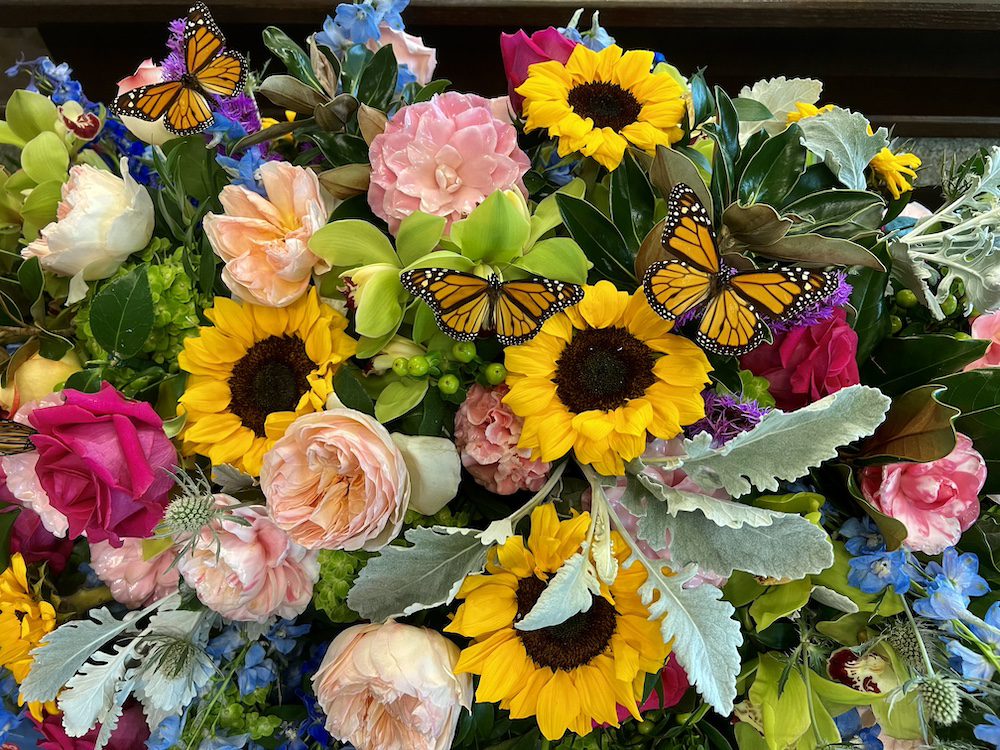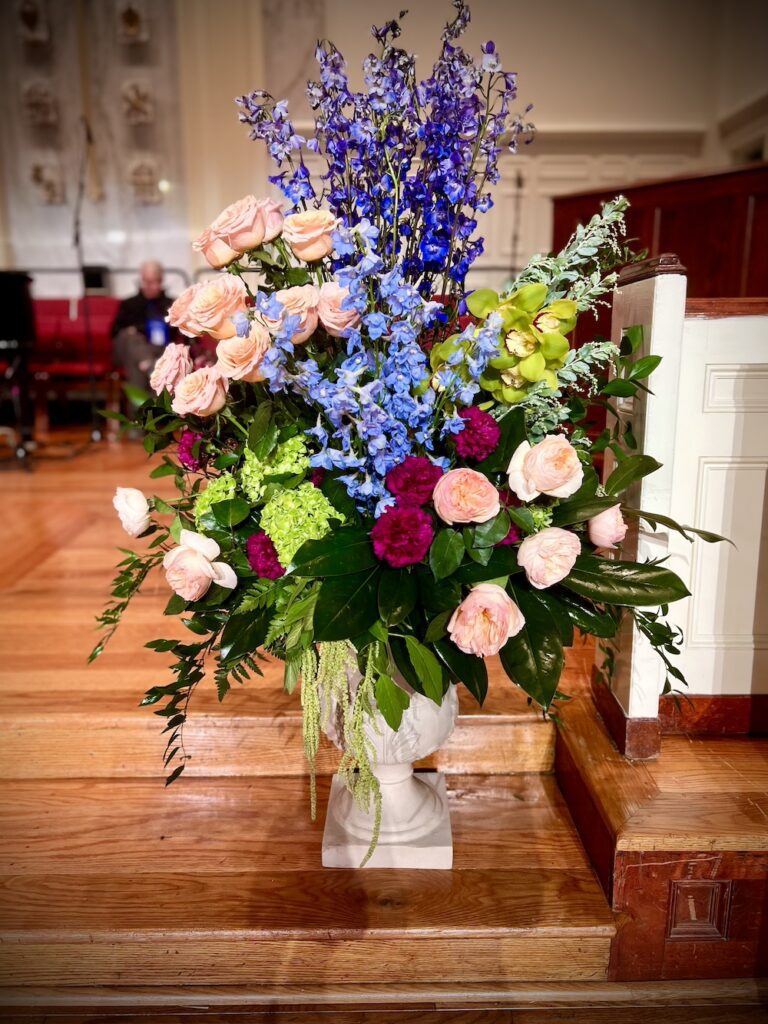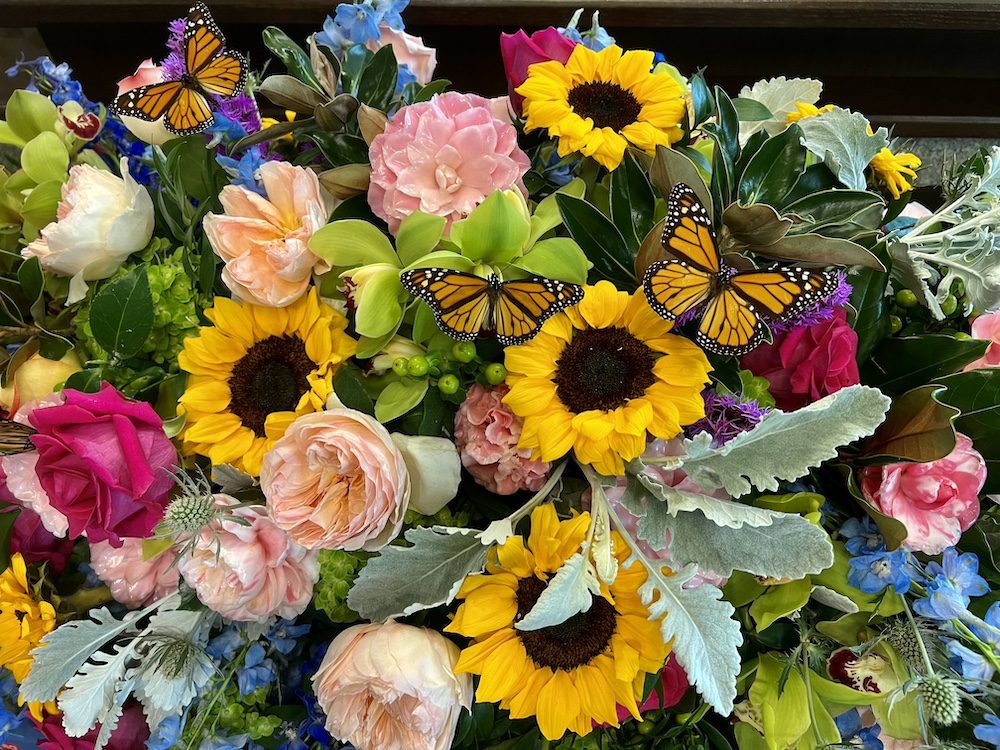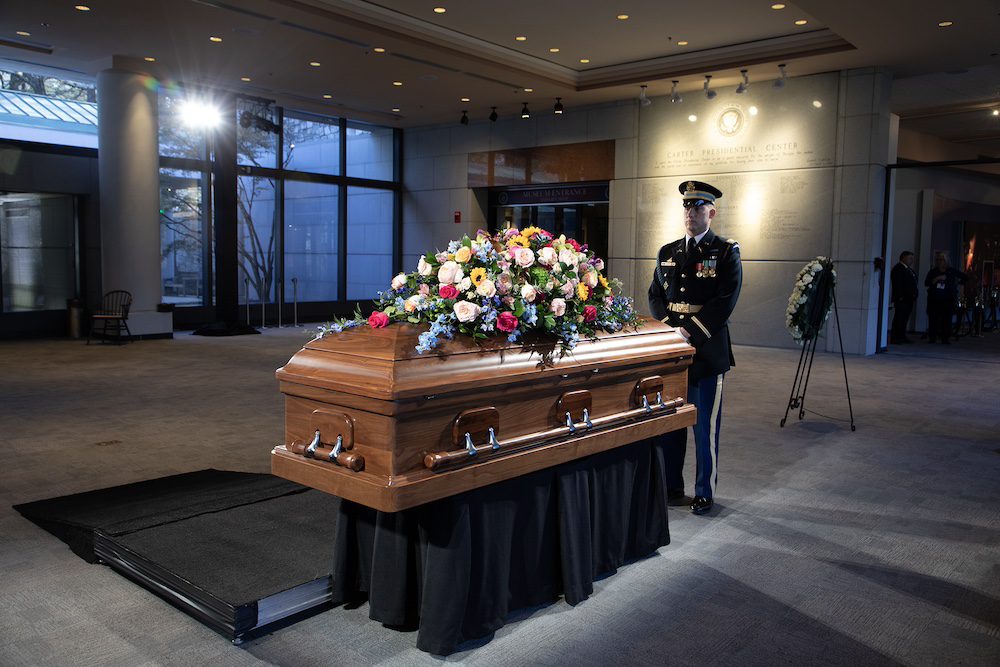Rosalynn Carter’s Vast Contributions to Flowers and Farming
By Jill Brooke

Former First Lady Rosalynn Carter understood the stories that flowers tell.
She and her trusted assistant of 38 years, Melissa Montgomery not only took in the sweetness of her favorite peach rose in the privacy of her home in Georgia, but also mapped out the flowers that would speak about her – when her funeral took place.
“In the composition of her floral arrangements, Mrs. Carter’s connection to her faith, gardening, farming, birdwatching, as well as monarch butterfly conservation and environmental protection are symbolized,” shared Montgomery.
You may have heard how her children wore bright-colored leis at the private funeral this week for their mother as a nod to her love of Hawaii and their parents’ love story. In fact, Rosalynn Carter, who died at the age of 96, would wear red carnation leis while campaigning for her husband.

“For part of his time in the Navy, President Carter was stationed in Hawaii,” said Montgomery. “Their son Chip Carter was born in Honolulu. Given Pastor Tony Lowden’s description of the funeral as a celebration of Mrs. Carter’s life, the festive flowers were appropriate.” Mrs. Carter had fun learning hula dancing while living there, and her son shared how she even won a hula-dancing contest.
That is why her sons, Jack, Chip and Jeff Carter, wore the Kukui Nut-Ti leaf shell leis which symbolize protection, peace and guidance. Amy Carter wore a double dendrobium orchid lei with roses to honor her mother. The orchid also represents love and Aloha.
As a reminder of their happy times in Hawaii, former President Jimmy Carter, 99, wore a special cigar lei with the Maile vine woven in with Kika flowers. Kika is worn by males and represents respect and affection.
Maile leis are traditionally reserved for royalty, but the Carters, a humble king and queen of altruism merited the tribute.

Her casket flowers told additional stories. Montgomery enlisted the talented team of Sherri Gerland and Michelle Gentile-Nascimento from the Floral Marketing International Group to create the floral storytelling.
Here Are the Flowers Used and Why

1. Bright Gem-Toned Flowers
Gem-toned flowers bursting with bright colors including a rocking Pink Floyd rose draped the casket. Other flowers were blue thistle, green hydrangea, purple liatris, purple carnations, dusty miller, green hypericum berries and sunflowers. “Rosalynn Carter loved color, and some of the jewel tones in the spray match jackets found in her closet,” said Montgomery.
2. Pollinator Flowers for Her Beloved Monarch Butterflies
The preserved monarch butterflies that danced around the roses, camellia and delphiniums were from Professor Jaap de Roode’s lab at Emory University and collected by Carter’s longtime Plains, Georgia, landscaper Annette Wise. “Each month, President Carter had lunch with various faculty from the university,” said Montgomery. “Jaap introduced him to the plight of the monarch butterflies and the loss of its habitat. Jimmy Carter told Rosalynn — and she embraced the cause.”
It triggered memories of her childhood “playing outside with butterflies fluttering around her mother’s flowerbeds and native tuberosa milkweed growing behind their home.” She then started The Rosalynn Carter Butterfly Trail in 2013, beginning as one garden at President and Mrs. Carter’s home.
“The monarchs reflected her interest in conservation and environmental protection,” added Montgomery. “Her tribute service, held at Glenn Memorial Church at Emory underscores that close association.”

3. Roses
A variety of roses were carefully curated to emphasize her Georgia roots. Because they couldn’t get Peace roses, which the former First Lady loved, the florists replicated it with the David Austin Juliet.
“The two-tone roses are called “Enchanted Peace,” and are also very similar to the Peace rose,” said Michelle Gentile-Nascimento.
Another special addition was the Dried Seven Sisters roses from her garden. Chip Carter recalls that President and Mrs. Carter were at a farm one Mother’s Day and saw roses blooming wild. They brought home cuttings and planted them along their home fence — coincidentally repurposed from President Nixon’s Key Biscayne residence — so they could enjoy them when they bloomed every year on Mother’s Day. Over time, these roses gave years of pleasure.

4. Magnolia and Boxwood Cuttings
Some cuttings from Jackson magnolia leaves were also introduced as a nod to their 1970’s White House years — and as a poignant example of how plants are a renewable part of history.
“These leaves belong to an enormous tree in Mrs. Carter’s front yard that was started from a sprout from the magnolia tree President Andrew Jackson planted in memory of his late wife on the White House lawn,” said Montgomery. “The Carters brought the shoot home with them from Washington.”
The team had other historic options before choosing the magnolia — a Carter family favorite.
“Harry Truman contributed English and American boxwoods to the White House grounds, and the Carters brought seedlings to plant in their yard in Plains,” said Montgomery. “They also have a pair of trees from seedlings from the Japanese maple Frances Folsom Cleveland planted. Across from their home is a tulip poplar grown from a seedling from a Mount Vernon tree. Lastly, they have an American elm from the South Grounds of the White House. Mrs. Carter remarked on the beautiful carpet of yellow leaves she remembered from her days in the White House.”

5. Camellia
The American Camellia Society honored the First Lady with a Rosalynn Carter camellia — and fate played a lovely hand in this inclusion. Rosalynn Carter camellias typically bloom in January, but remarkably, on the day of her hospice announcement, a few Rosalynn Carter camellias bloomed in her yard in November — later used in the funeral spray. Camellias are typically too fragile for arrangements so Annette Wise waxed the flowers to include in the spray.

6. Orchids
Among the orchids in the spray were green cymbidium orchids.
“Mrs. Carter loved all flowers, but she did have a particular fondness for orchids,” said Montgomery. “Her sunroom at home is frequently graced with profusions of blooms from her sizeable collection. Her plants rest on a specially designed table her husband hand-made for her.”
It is a bit curious, considering the Carters were farmers, that other First Ladies are often cited for their connection to flowers. Lady Bird Johnson’s love of wildflowers, Nellie Taft’s cherry blossoms or Jacqueline Kennedy’s elegant entertaining. Michele Obama is known for her vegetable garden and organic flowers.

Rosalynn Carter deserves to be in that pantheon. She had a deep connection to flowers— not only in aesthetic appreciation but in understanding how flowers grow. From 1971-1975 in the Governor’s mansion, as she wrote in her book, “First Lady from Plains,” she “planted candytuft and pansies. Crocuses in the springtime, and tulips, begonias and geraniums. And I could work it in even when the tourists were there. They never expected to see me in my jeans and they’d walk right by without recognizing me.” She conversed with growers who even sent rose bushes from California.
And without a meaningful flower budget, before her White House years, while entertaining 750 people a month, she learned arranging by buying books. “I studied the pictures, planted the beds,” Rosalynn Carter said. “I soon learned that I liked flowers in profusion in the vases. Spring flowers or roses or whatever happened to be blooming in the yard, or even greenery, when there were no flowers. For big events, such as legislative dinners, volunteers from the Garden Club of America in Georgia helped out,” she added. Flowers, she knew, made people happy.
Though known as a capable no-nonsense, no-fuss woman, she also possessed a delicate graciousness that extended like branches and touched many people. Her authenticity in truly wanting to learn more about gardening and farming trends helped millions. Her work in Africa investing in farming techniques tripled grain production. “It’s really wonderful to have a farmer running out to greet us saying, “My son has come home from the city because now we can raise enough food grain on our land to support the whole family.”
Flowers, she knew, also comforted. Of her many contributions, she started the Rosalynn Carter Institute for Caregivers.
So it’s no surprise there are Jimmy Carter camellias, Rosalynn Carter and Jimmy Carter native azaleas, a Rosalynn Carter rose, and a Rosalynn Carter orchid named in her honor.

She also understood how flowers teach lessons of resourcefulness, adaptability and hope. Sunflowers were purposefully set among the blooms that Sherri Gerland and Michelle Gentile-Nascimento from the Floral Marketing International Group tucked into her casket display.
“The sunflowers represent Mrs. Carter’s rural life and her love of birds and butterflies,” said Montgomery. It’s also fitting, as she advocated for mental health programs. The dark center of the sunflower may represent the darkness that exists in life, but the yellow petals lean toward the sun, a satellite dish for happiness and hope.

For her final service in Georgia at the Maranatha Baptist Church, the team added delicate white Dogwood blooms to add a special touch. “It was chosen to honor her strong faith in Jesus and the Resurrection,” said Montgomery, as the language of dogwood flowers represents rebirth and durability. These flowers were also included in the funeral wreaths.
“Those are symbolic to her home state of Georgia, where Dogwood trees bloom every spring,” says Gentile-Nascimento. “At the end of the interment, family members were invited to pull an item from the spray to take with them. The items they take away can represent their memories, as individual as their choices in the spray.”
The flowers, each singular and distinct, represent the variety of causes and beauty Rosalynn Carter gave the world. The Carter Center will continue that legacy.
With President Carter now very frail, Montgomery says they have cherry-picked plans for him too. But the flowers will not be the same. After all, this was Rosalynn Carter’s life to share. As she said, “Do what you can to show you care about others, and you will make our world a better place.” Throughout history, flowers are certainly a messenger for that goal.

Jill Brooke is a former CNN correspondent, Post columnist and editor-in-chief of Avenue and Travel Savvy magazine. She is an author and the editorial director of FPD and a monthly contributor to Florists Review magazine.
Photo Credit: Floral Marketing International Group, Carter Center
